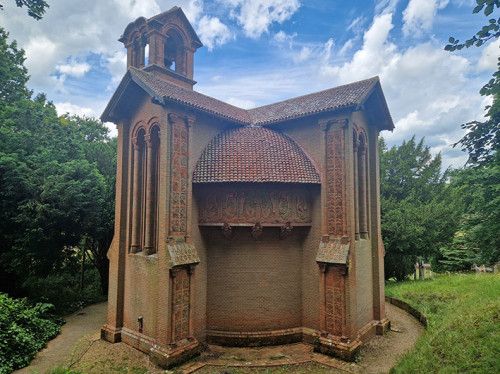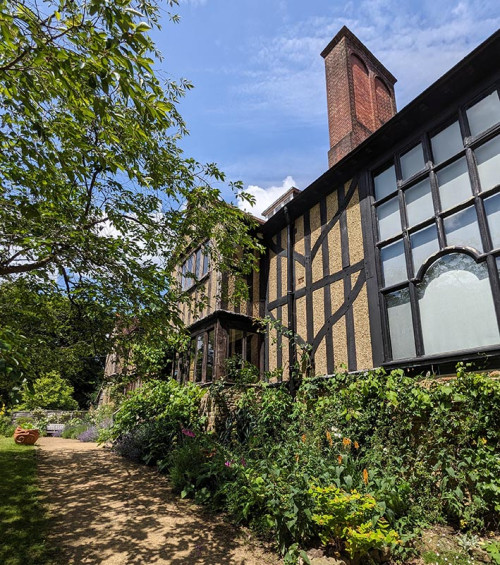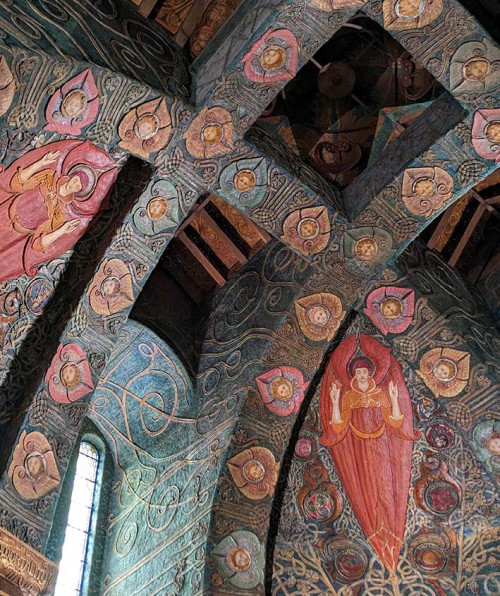Watts Gallery Visit
26 June 2024 by Andrew Pizzey
Old browser alert! We have detected you are using a pretty old browser. This website uses cool features that can't be supported by your browser.
If we let you see the website it would look all weird and broken, nobody wants that!
Update your browser!26 June 2024 by Andrew Pizzey

On a sunny June day the whole George & James team had we had the pleasure of visiting Watts Chapel, Artists Village, in the village of Compton near Guildford in Surrey, including a guided tour of Limnerlease House and the Watts Chapel.
In the 1890’s, two artists George and Mary Watts, created a unique group of buildings in the Surrey hills. During their lifetime they had a house built including an artists studio, built a Chapel, pottery and picture gallery. After lots of fundraising, grants and the hard work of passionate and friendly volunteers these these buildings are once again able to be visited and be a design inspiration for a new generation.

We started our visit with tour of Limnerlease, an important arts and crafts building designed by Ernest George who ran a large London practice in which many important architects such as Edwin Lutyens trained. Built in 1891 it served as the Watts’s’ country home, often an important escape from London for George Watts infamous ill-health.
However, it was not just a place of refuge it also became a place of work and famously the Watts Studios located on the eastern side of the house. A lot of high-profile friends and admirers would travel to Limnerlease to visit the beloved George Watts, so often that a viewing gallery above his studio was constructed so visitors could watch him at work.
George's Studio now open to the public benefits from a vaulted ceiling and large windows. The scale of his paintings meant a pulley system was constructed with a special hatch in the floor so that his largest paintings could be raised and lowered to allow Watts to reach all its surface. For this reason, the room was very tall in relation to its width, it had been described to have the similar atmosphere as a renaissance chapel.
Mary had a significant impact on the interior design of the house in particular the decorative ceilings which she sculpted out of gesso. Mary trained in sculpting and from her travels with George became particularly fond of symbolism. The low relief gesso panels in the hall and red drawing room ceilings were sculpted carefully by Mary, the symbols suggest the joy in which she found in her husband. We can depict in these panels the sun, bees, birds, butterflies, grapes and wheat – signifying energy, industry and the fruits of labour.

The Watts Chapel is the masterpiece and testament to Mary and the local community who it was decorated by entirely. The Chapel is recognised as one of the most important Art Nouveau Buildings in Britain. Built on Budborough Hill by Mary and the community of Compton between 1895 and 1904, it almost resembles a Byzantine or Orthodox Church with its half round clay tile and its circular intersected cross plan again all inspired from her travels with George. Georges only contribution appears to be one of financial support.
Mary began holding classes at Limnerlease training the Compton community in the craft of making terracotta panels to decorate the exterior of the Chapel. Mary continued her interest in symbolism and introduced it to the interior and exterior of the Chapel this time as well as using her travels as inspiration she also used her Scottish past and heritage, including symbols of Celtic, Romanesque, Jewish and Egyptian traditions. Whilst still most certainly Christian, the Watts Chapel was consecrated in July 1898.
Mary’s belief that the symbolic systems of different historical civilisations could be synthesised into a universal language of fundamental human concern.
The Chapels envelope materiality was primarily red clay bricks from a brickworks near Guildford. Mary purposefully chose a small brick to give the illusion that the structure stood taller and narrower amongst its landscape emphasising its Byzantine aesthetic. The Watts Chapel was fully completed in 1904 with the finishing touch an installation of The All Prevading by George Watts. George died shortly after the completion of the Chapel on the 1st of July 1904, where his ashes remain in the cemetery.
Mary continued her classes in terracotta and clay modelling as regular evening classes, she in fact found a seam of red clay within the grounds of Limnerlease itself! With the enthusiasm of the Compton community growing in the craft of clay Mary felt ready to take one step further starting a fully functioning pottery business. Mary passed in 1938 and the Compton Pottery decommissioned in the mid-1950’s. Compton Pottery is still associated strongly with its locally sourced terracotta, most distinctively the chunky garden pots which are now highly valued once more.
We had a great, truly insightful visit to the Watts Artistic Village our greatest thanks go out to the Watts Gallery Team. If you have enjoyed reading this and like the sound of journeying through the bright past of Compton and the Watts’s’ please do visit the Chapel and Limnerlease are open to the public with paid tours and gallery entrance available to organise with the team via their website.